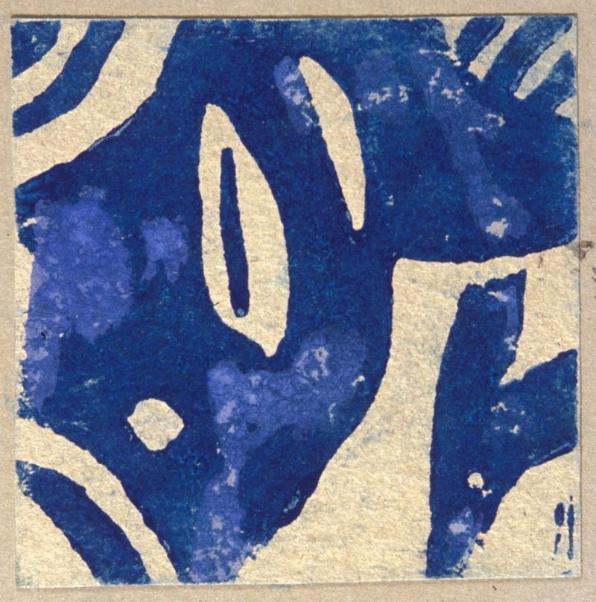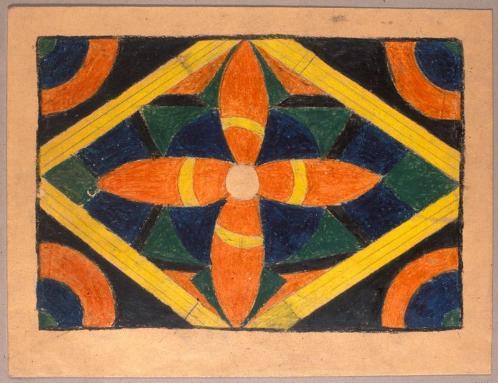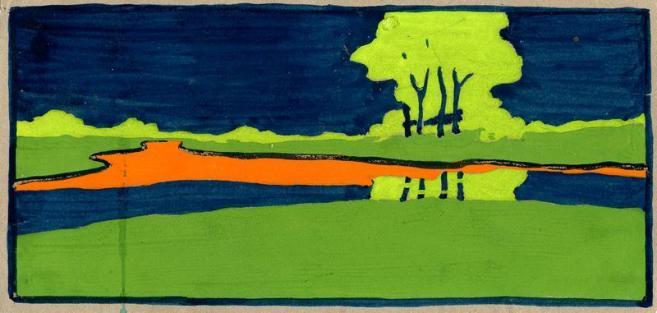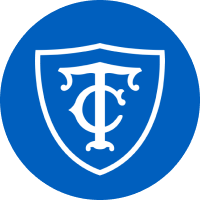Be a Detective: Art, Artifacts, and Artful Historical Research

If you are curious about the history of art education, anatomy of artifacts, and nature of historical research, then this guide will serve to illuminate. Think of yourself as a detective, with an insatiable desire for knowledge and a keen eye for observation. You follow clues to solve the mystery of an object, text, or image -- how and why it comes to be, what it tells us about teaching and learning, perhaps even when it begins to shape theory and practice in the field.
As teachers in training, you might examine a letter from Pearl Greenberg to Angiola Churchill; photograph of art students modeling a Greek cross; or film that shows how New Lincoln Schoolers grow through art. Can you write a biography of an historical artifact, such as a Victor D'Amico Art Barge Blueprint, or a box of lantern slides? With creative skill and taste in hunting down clues, comes logical reasoning in piecing information together and telling a good story.
For an interesting angle, you might read, The Object: Lost and Found, in which Victor D'Amico describes how learning to "find" art involves curiosity in seeing; courage to look for the unexpected and the unfamiliar; sensitive choice; and conviction, using proof or evidence, to make the judgment that the found object, place or thing has aesthetic value. These same principles can be considered in the process of historical research which bears appreciation of primary sources as valuable educational tools.
In this guide we highlight key institutional publications that inform the development of art education, while drawing attention to digital repositories, archival catalogs, local art archives, and other helpful resources. Also included is a listing of sample artifacts to spark your quest. This blog post complements Dr. Ami Kantawala's presentation, Primary Document Analysis: Biography of a Historical Text for the class, Historical Foundations of Art Education (A&HA4085).
Image: Practice-Teaching: Detail Of GL00-BB04-FF05-DR03-0053 (n/a, 1904-1922), by Unknown. Students of Arthur Wesley Dow Collection. Courtesy of the Gottesman Libraries, Teachers College, Columbia University.
Key Institutional Publications
Here are a few publications that offer great insight into the mission and vision of art education at Teachers College, Columbia University, a pioneer in the field.
- Announcement of Teachers College (Course Catalog/Bulletin), 1910-1998. Descriptions of courses, college mission, faculty. Also see the TC Academic Catalog Archives, 1999-present.
- Experimental and Demonstration Schools at Teachers College. Insight into the practice of teaching art to children in Kindergarten - Grade 12.
- Teachers College Curriculum Studies Program - a collection of 20th century American curriculum guides produced by state and city boards of education.
- Teachers College Record, journal of research, analysis, and commentary in the field of education -- published continuously since 1900. Includes notes on our faculty, students, alumni, professional activities, and more. See here for free subscription.
- Wygant, Foster. A History of the Department of Fine and Industrial Arts of Teachers College, Columbia University. Teachers College, Columbia University, 1959. A comprehensive overview of the birth and growth of Art Education at TC, including listings of faculty members, courses, etc.
Alumni /Faculty Papers*
What would Teachers College be without its faculty and students? Noted here are a few leading members in the field:
- Angiola Churchill (1922 -). Artist and Art Educator, New York University. Professor emeritus of New York University and former Chair of the Department of Art and Arts Professions, 1975-2005. Founder/director of the New York University studio art program in Venice, 1974-2006; and co-director of the International Center for Advanced Studies in Art. She has had numerous one-person exhibitions and participated in more than 54 group shows, biennials and art fairs. Angiola took her Ed.D. in Art Education in 1970 and taught in the Program from 1996-2006. She is author of the classic text Art for Preadolescents (New York, McGraw-Hill, [1971]).
- Victor D'Amico (1905-1987). Director of the Education Department at MoMA. Studied at Teachers College Columbia University between 1920 and 1930. Head of the art department at the Fieldston Schools from 1926 to 1948 and taught at Columbia TC (1934-42), New York University (1965-72) and Southampton College (1969). He was a pioneer in art education and the director of the education department at the Museum of Modern Art for more than 30 years. Among his writings is the classic text Assemblage: A New Dimension in Creative Teaching in Action (New York, MoMA, [1971]) and Art for the Family (New York: MoMA, [1954]).
- Arthur Wesley Dow (1857-1922). American painter, printmaker, photographer, influential art educator, leader in the Arts and Crafts Movement. Author of Composition: A Series of Exercises in Art Structure for the Use of Students and Teachers (New York, Baker & Taylor, 1900).
- Al Hurwitz (1921-2012). National and International Art Educator, Maryland Institute College of Art, Baltimore. Hurwitz's career in art education spanned 50 years and included teaching at all levels, as well as serving as supervisor of art in the Miami-Dade County (Fla.) school system, the Newton (Mass.) Public Schools, and Chair of Art Education at the Maryland Institute College of Art. During his tenure in Massachusetts, he studied at Teachers College and earned his doctorate in art education from the Pennsylvania State University. Hurwitz was active in international art education and served as president of both the National Art Education Association (NAEA) and International Society for Education through Art (INSEA). Among his co-authored works are the classic texts Children and Their Art (New York: Harcourt, 1970) and Memory and Experience (Cairo, Dar El Maaref, 1993).
- John F. Lidstone (1930-1994). Dean of Education, Queens College, New York. Founder of the University Council in Art Education. The first dean of the School of Education at Queens College in New York and an authority on design in art education. Lidstone wrote numerous books and articles and was a contributing editor at School Arts Magazine. He provided leadership for the founding of the New York–based University Council on Art Education. Among his written works are the classic texts Design Activities for the Elementary Classroom (Worcester, Mass: Davis, [1964]) and Working Big (New York: Van Nostrand Reinhold, [1975]).
- Pearl Greenberg. Weaver and Educator, Kean College, New Jersey. A fine arts teacher for almost 30 years at Kean College, a Distinguished Fellow in the National Art Education Association, and the author of many books and technical papers on the crafts disciplines. Distinguished Fellow in the National Art Education Association and early founder of the New York–based University Council for Art Education.
- Edwin Ziegfeld (1905-1997). Founder of International Society for Education Through Art and the first president of the National Arts Education Association. Ziegfeld taught fine arts at Teachers College of Columbia University for more than 30 years and his publications include Education and Art: A Symposium (Paris: UNESCO, 1953).
* From the TC | AAE Distinguished Alumni page where you can see leaders in the field, including Agnes Martin and Georgia O'Keeffe
Institutional Repositories
Our institutional repositories are growing rapidly and more accessible, as more materials are digitalized. At Teachers College, our scope covers materials essentially to, by, and about our institution and its members and their contributions to the broad fields of education, psychology, and the applied health sciences.
- Teachers College Digital Collection - The digital archive of Teachers College, including unpublished manuscripts and archives from the library's collections, documents from other departments and administrative offices College-wide, and the work of TC students, faculty, and researchers.
Art collections featured:
Federico Castellon Memorial Print Collection
Historical Photographs of Teachers College
Morton Schindel Animation Cels
Passow Collection of Israeli Children's Peace Art
Students of Arthur Wesley Dow Collection
Ukrainian Children's Art Collection
Ziegfeld Collection of International Children's Art
Rothman Lantern Slide Collection
- Academic Commons - Columbia University's online repository, where current faculty, students, and staff can deposit the results of their scholarly work and research. Select Archival Catalogs The following sources will help you explore the holdings outside of Teachers College and Columbia University.
- Access to Archival Databases (AAD) System - Index to records for files from the National Archives.
- Accessible Archives - Searchable collection of U.S. history resources, including the Pennsylvania Gazette, the Civil War coverage of three newspapers, Godey's Lady's Book, a group of African-American and abolitionist newspapers, and selections from several 19th century Delaware Valley newspapers.
- ArchiveGrid - Archival finding aids and citations for thousands of libraries, museums, and archives. An open source drawn from records in Worldcat.
- Archives of American Art, Smithsonian Institution - The largest collection of primary resources documenting the history of the visual arts in the United States.
- Guides to Microforms: Primary Sources in U.S. History - Guides to microform sets in American history, foreign relations, women's studies published by University Publications of America.
- National Archives - Produced by the National Archives and Records Administration (NARA), an independent agency of the United States government, which is officially responsible for maintaining and publishing the legally authentic and authoritative copies of acts of Congress, presidential proclamations and executive orders, federal regulations, and a wealth of other historical documents and records. Sample NYC Art Archives Consider visiting these nearby collections as you start your project!
- Avery Drawings & Archives Collection, Columbia University, consists primarily of drawings and architectural records by American architects of the 19th and 20th centuries. We hold a diverse range of original and reprographic drawings, photographic materials, project and building files, business papers, correspondence, diaries, scrapbooks, and faculty and personal papers. Within the collection, there are also a limited number of non-architectural drawings by architects, for example, figure studies done by architects while in school.
- The Frick Collection provides a Directory for the History of Collecting in America, a resource created to help researchers locate primary source material about American art collectors, dealers, agents and advisors, and the repositories that hold these records. .
- The Met Archives, within the Watson Library, has records and official correspondence of the Museum. The archives are accessible to qualified scholarly researchers at the graduate level and beyond. An e-mail and resume must be submitted and reviewed at the discretion of the staff. Appointment then required.
- MoMa (Museum of Modern Art) lists administrative papers and records; records of outside organizations and individuals; unprocessed records; restricted records; and collections promised. Finding aids are accessible. An appointment is required.
- New York Public Library has digitized more than 180,000 images for the public domain. Digital collections include prints, photographs, maps, manuscripts, streaming video and more.
Other Helpful Resources
- Educat+, the record of the Gottesman Libraries' holdings
- Biography Databases, to verify biographical information; especially note those covering artists
- Historical Newpapers, for leads on people, places, activities, etc.
- Research Guides for descriptive subject guides at program level; specifically, Art and Art Education

Image: Practice Teaching: Seventh Grade: Detail Of GL00-BB04-FF05-DR02-0041 (n/a, 1904-1922), by Unknown, from The Students of Arthur Wesley Dow Collection. Courtesy of the Gottesman Libraries, Teachers College, Columbia University
Locating Physical Archives
(prepared by Lea Lange)
There are several ways to locate primary resources that may be of interest to you. These include searching online catalogs, national or institutional archival databases, or inquiring directly at individual institutions. Any institution could potentially have an archive, from a small theater to governmental agencies or corporations. If you have an interest in a particular institution, you should contact that institution directly to inquire if they have an archive and whether you may access it. Here is a very small selection of some of New York City's largest institutions with physical archives:
- Finding Aids Portal for New York University's Fales Library & Special Collections
- New York City Board of Education Records, 1842-2002 - Records of the Board of Education, from its creation in 1842 to its replacement by a mayoral Department of Education in 2002. Also included are records of the Board of Education of the City of Brooklyn from 1853 to 1897. These records document aspects of educational policy-making and school-system administration. Located at the New York City Municipal Archives. See here for the Digital Gallery of New York City Board of Education photos.
- If you are curious to see where else in the world collections on an individual or group may be held, you can search WorldCat (short for "world catalog"). To do this, use the advanced search, select "archival material" as the format, and search by keyword. Once you locate a collection of interest, you can inquire at the individual institution to get access.
Using a Finding Aid
Finding aids are the documents created by archivists to describe and give context to collections and help users identify what parts of the collection are of interest to them. They usually consist of the following sections, which may vary in title:
- Title and years of coverage: The title is usually the name of the person who collected the documents. While the collection will be most closely related to this person, it may hold contents of interest on other individuals. Be sure the years match those you are interested in.
- Overview: provides the size of the collection (usually in linear feet or number of boxes), its creator, and a brief abstract.
- Administrative information: details guidelines for citation and any access restrictions.
- Historical or biographical note: summarizes the life of an individual or the history of an institution and can serve as a starting point for further biographical research.
- Scope and content note: describes the content of the collection including topics, types of materials, and years covered.
- Arrangement: lists the hierarchical order of the collection as it has been arranged in the archive.
- Box and folder list: details the box and/or folder numbers of the collection and their contents.
Knowing these essential parts of a finding aid can help you decide if a collection is relevant and which boxes or folders to request when onsite. It is important to note that access policies vary by institution and by collection, so you should make sure you are able to access a collection before visiting the institution.

Image: Color Exercises 4, by Unknown. Students of Arthur Wesley Dow Collection. Courtesy of the Gottesman Libraries, Teachers College. Columbia University
Materials, Resources, and Topics
Textiles, Practical Arts, and the Advancement of pedagogical training for Women and Children
Notebook Kept by Dorothea Donnen for Textiles 31 Course Spring 1913 (RG 29)
Adelaide Nutting Textile and Ephemera including cuffs and hats worn by students.
Nursing Education Photos—Glass Negatives
High School Home Economics “Samplers.” Acc. No. 091692. MG 120. NYC. Donated by Marie Dasto.
Industrial Arts Manual Training from LiIbrary Vertical Files (RG10)
Kindergaten Training Materials (Anna Steifel MG 60)
Angiola Churchhill collection box 9 collection of stitched and handmade objects using textiles
Dewey Laboratory School, AG 18. Photograph album with photos, circa 1900, from the Laboratory School documenting learning activities and art objects and projects constructed by the students. Donated by Lawrence Cremin on August 18, 1990. Boxes 2 of 2.
TC Art from the Dow Years: Broadening Horizons
Dow students artwork from “Johnson Show”
"TC Art from the Dow Years”: Box containing a catalog, postcards, brochure, poster made in the Art Department, 1914-1916? Acc. No.: 871201 and 871210. Box 1 of 1. Note: The catalog represents the sale of Dow art collections. Several of these items were on loan in 1983-1985 for exhibition purposes at The Tyler Art Gallery
Everyday Life as History, In Art
“John Jackson Drawings of Teachers College” (AG 19). Found in former TC Vice President Nate Dickmeyer’s office in 1995, these works represent scenes of daily life at Teachers College. The works are of an undetermined medium, either drawings or prints, in a mixture of techinques and undated (but likely from 1925), with indeterminate penciled notes around the perimeter
Book: Amoenitates Altdorfinae, 1720. This book details everyday life in or around Nuremberg University of Altdorf
The Ukrainian Children’s Art Collection
Typography and Visual Acuities, From Fine Art to Juvenile Literature
Cuala Press typography
Art Typographica (Spring 1918)
Select Bookplate from Bookplate Annual, 1922
Children’s Book Art Illustration and Authors (AG 23, Boxes 3 and 4)
Student Developed Publications including The Phoenix, a student run, predecessor publication to Lincoln School’s, The Lincolnian
A Picture is Worth a Thousand Words, Materials, Technology, and Pedagogy
Box of Lantern Slides. Edward Van Altena. See Rothman for examples in K-12 teaching.
Ukrainian Childrens Education Photos
2 Darregotypes of Horace Mann
Dewey Laboratory School, AG 18. Photograph album with photos, circa 1900, from the Laboratory School documenting learning activities and art objects and projects constructed by the students. Donated by Lawrence Cremin on August 18, 1990. Boxes 2 of 2
Unknown Objects, What Shall We Do?
Old Syrian Health or Medicinal Bowl made of copper (M15)
Florence Nightingale Brick
Meilatz (15 Works)
Adelaide Nutting Collection Ephemera and Objects
Teachers College International Engagement in the Far East.
Chinese Wood Block. AG4. Formerly MS 124. Gift of Professor Monroe.
Japanese Wood Block
Kammava — Burmese Manuscript, 19th Century— 6 leaves (4 7/8 x 21 inches), each lacquered in red with elaborate overall decoration in gilt, 14 leaves with lines of black/dark brown lacquer text in square script (known as 'magyi-zi) recto and verso, two leaves with text on one side only, the other with an overall decoration in gilt.
Unbound as issued between a pair of red lacquered teak boards, gilt decoration on outer surfaces, inlaid with glass mosaic decoration, Housed within a modern dark red morocco backed box.
Scrolls, 2 Chinese (circa 1948) Scroll 1. There are 11 characters. Two characters are a group. The last group contains three characters. The 1st group means harmonic. The 2nd group means a kind of color paint. The 3rd group means a good smell. The 4th group means two fruits (peach and plum which in Chinese culture symbolizes a large number). The last group means abundantly, overflowing. Translation: a) First 4 groups involve TC students. b) The last group means TC will maintain its historical status in education and wishes TC will continue to educate lots of students. (In plain translation, it also means “overflowing”.) c) The left tiny characters signify Chinese year 37 June (which in AD is June of 1948). d) The lower left contains the name of the person who wrote the scroll. Scroll 2. a) There are 11 characters. Four characters are a group. The last group contains three characters. The first group in plain translation is "think about where the water comes from when you drink it". In Chinese this means, never forget that everything we have right now comes from the efforts of people long ago. It also describes "thankful". b) The other two groups (or phrases) are not recognizable. c) On the right side the tiny words denote “a gift from the Columbia University Teachers College Chinese Student Association."d) The left part in plain translation means "mother, school, for memory". “The gift is given as a memory to TC. Another hint of "mother" means TC is just like mother who gives "birth" and "educates" each student. - See Introducing English Poetry to Chinese College Students, by Hsiao-chuan Liu
Labor, Politics, and Iconography
Ukrainian Childrens Education Photos
"TC Art from the Dow Years”: Box containing a catalog, postcards, brochure, poster made in the Art Department, 1914-1916?
Note
See the accompanying guide, Archival Exercises: A Lens on Underrepresented / Marginalized Histories.

